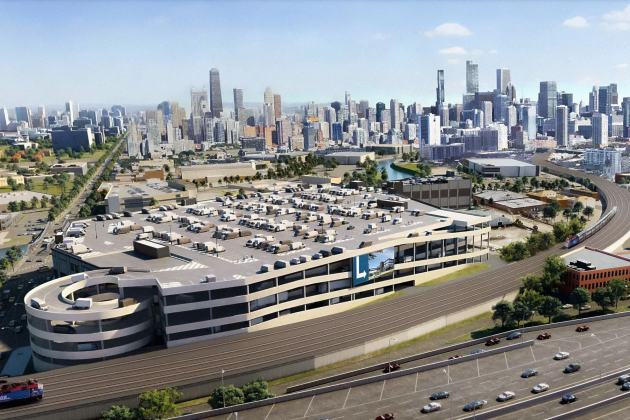Are Urban Warehouses the Future of Last-Mile Logistics?

Many retailers have reevaluated their warehousing investments since e-commerce demand cooled after a searing pandemic growth streak.
To capitalize on last-mile delivery growth, retailers should consider the upsides of vertical urban warehouses versus the usual sprawling facilities outside of but adjacent to big metro areas.
More from Sourcing Journal
U.S. cities are seeing an influx of multi-story warehouses after this real estate strategy found a foothold in high-population areas in China, Singapore and Japan. These facilities reside at the “intersection of population and congestion,” said Leslie Lanne, JLL vice chairman. The first of U.S. facility of its kind was built in Seattle in 2018—a three-story warehouse measuring 590,000 square feet.
“The feature that sets these distribution centers apart from other traditional warehouses and distribution centers is these are designed to be outbound facilities for the most part,” Lanne said. “This is not long-term storage. This is not usually a high-touch type facility. This is here to move goods out the door incredibly quickly, to the population bases around us.”
The most important criteria that sets a multi-story building apart from its cousin, a mezzanine building, is that there are loading docks on more than one level, according to the report.
“We’ve found it to be critical to try to get the vehicular traffic into the facility and off of the city streets, so they can queue effectively,” Lanne said. “We don’t want to have a whole bunch of delivery vehicles sitting on our city streets, further adding to the congestion issue.”
Since many of these multi-story warehouses are located in areas that also serve as last-mile distribution hubs, one floor can serve as the distribution center while others might serve as a makerspace. According to Lanne, these facilities may have entire floors above the warehouse areas that are solely dedicated to fleet parking or electric vehicle charging.
As automation continues to transform traditional warehousing, it’s infiltrating multi-story facilities, too, Lanne observed.
“Everyone’s looking for efficiency, especially when we rely on efficiency and speed to get the goods into the hands of those consumers and businesses,” Lanne said. “Anything that can be done inside the box, and anything that others are trying in a suburban environment is being test run out and then installed in these as well.”
Robotics platforms like Attabotics and Urbx would fit well within the parameters of multi-story warehouses. They leverage space both vertically and horizontally to help companies adapt to their industrial real estate footprint. The storage units are serviced by robot pickers that shuttle product to stations where humans work. The modular, scalable storage structures can expand when companies need extra storage during high-volume periods, or contract during low-volume stretches.
Emerging urban logistics markets such as Atlanta, Miami, Dallas, Houston and Seattle are prime targets for multi-story warehouses. Current established markets include Los Angeles, Boston, Chicago, Philadelphia and New York—the last of which has 9.4 million square feet of last-mile logistics space under construction.
Lanne said these markets are the best-suited for the multi-story facilities due to their proximity to clients.
“It’s not just about home delivery,” Lanne said. “There’s many businesses that need very quick delivery times for their goods. You have to embed these sort of distribution centers so that you don’t have barriers from a time perspective, so those markets have those attributes.”
Multi-story warehouses should accommodate newer modes of delivery, according to JLL. Historically speaking, delivery vehicles were usually bulky box trucks, but companies in urban core areas are also using electric bicycles and scooters to meet the growing demand two-hour or same-day delivery.
Cost is the biggest drawback to multi-story warehouse expansion. Real estate accounts for about 5 percent to 8 percent of operating costs in a suburban environment, according to JLL. However, those numbers jump to about 8 percent to 10 percent in urban markets with vertical buildings due to higher infrastructure costs and additional square footage needed for parking, loading space and similar considerations.
Lanne said we’re in “version 1.0” of the multi-story warehouse phase. She expects the dynamic to evolve as retailers of different sizes require different amounts of space.
“We’re seeing a diversification in size ranges as the sites become less available, and we might have to look to do some of these projects on smaller acreage to see what these buildings look like and how we’re changing the design. And just as importantly, we’re being able to offer all of these kinds of Class A building attributes to tenants, not only that are hundreds of thousands of feet, but in the 40,000-to-80,000 square feet range.”

